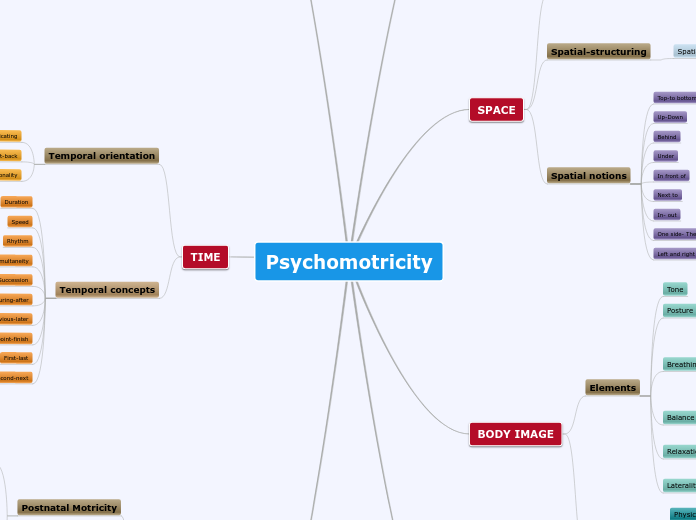Psychomotricity
LATERALITY
Factors
Neurophysiologic
Hereditary
Cultural and environmental
Types
Right-handedness
Left-handedness
Ambidexterity
Cross-dominance or mixed candedness
False laterality
Evolution
Indifferent (0/2 years)
Alternating (2/4 years)
Define (4/6 years)
SPACE
Spatial-orientation
Motor manifestation
Reagroupings
Divisions
Evolutions
Spatial-structuring
Spatial relationships
Topological relations
Euclidean relations
Projective relations
Spatial notions
Top-to bottom
Up-Down
Behind
Under
In front of
Next to
In- out
One side- The other
Left and right
BODY IMAGE
Elements
Tone
Posture
Breathing
Diaphragmatic
Thoracic
Clavicular
Total
Balance
Relaxation
Analytical or segmental
Globar or total
Laterality
Influences
Physical
Mental
Emotional
Social
What we're working?
Awareness of his own body
Mastery of tone, posture and balance
Posibilities and limitations of the body
Coordination and control of motor skills
Orientation temporary space
Help and collaboration with colleagues
Acquisition of autonomy
Health and care of oneself
Development of rhythm
Corporal and musical languaje
Dynamic and static control of the body
HISTORY AND EVOLUTIION
Laws for motor skills development
Cephalocaudal law (Craneal to Caudal)
Proximodistal law (Proximal to Distal)
Flexion to Extensión law
Gross to finer law (Simple to Complex)
Some theories of motor development
Piaget's stages of intelectual or cognitive developmen
SENSORIOMOTOR (0/18-24 months)
Quick changes
Non willfulness
No autonomy
Slow attention
Radical egocentricy
Inestability
PREOPERATIONAL (18-4/7 years)
Small attention
Need activity and continous change
Motor and cognitive walk together
Symbolism
CONCRETE OPERATIONAL (7/12 years)
Reasoning
Discoverment of the world
Play rather than symbolism
FORMAL OPERATIONAL (adolescence to adulthood)
Abstract relationships
Formulate hipotheses
Wallons psychobiological theory and human development
IMPULSIVE AND EMOTIONAL STAGE (6/12 months)
Emotions
Preponderant role
SENSORIOMOTOR STADIUM (12/24 months)
Organized movement
Desire to explore the world
PROJECTIVE STAGE (2/3 years)
March
Exploration
Languaje training
PERSONALISTICO STADIUM (3/6 years)
Lateral dominance
Spacial orientation
Construction of the self
STAGE OF THE CATHEGORICAL THOUGHT (6/12 years)
Objective-Subjetive
PUBERTY STADIUM (12 years)
Affirmation of the self
Affective conflicts
TIME
Temporal orientation
Planing, organizing, comunicating
Concept left and right, up-down, top-bottom, front-back
Laterality and directionality
Temporal concepts
Duration
Speed
Rhythm
Simultaneity
Succession
Before-during-after
Previous-later
Start point-finish
First-last
Second-next
MOTRICITY
Postnatal Motricity
Réflex action
Withdrawal reflex
Knee-jerk reflex
Gag reflex
Blink reflex
Pupillary reflex
Voluntary motor action
Muscular tone, Postural Control and Balance
Locomotiion motricity
Manipulation
Graphic motricity
Space-time orientation
Psychomotor capacities
Muscular tone
Postural control
Ventral position
Head support
Sitting down position
Standing up position
Balance
Static
Dynamic
Post movement
Object Balance
Locomotion motricity
Floor movement
Rolling
Drawling
Crawls
Creep
March
Run
Jump
Somersault
Longitudinal axle
Transversal axle
Posterior and previous axle
Handling Skills
Prehensile
Throwing
Catching
Hitting
